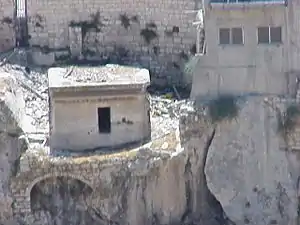
The Monolith of Silwan, also known as the Tomb of Pharaoh's Daughter, is a cuboid rock-cut tomb located in Silwan, Jerusalem[1] dating from the period of the Kingdom of Judah; the latter name refers to a 19th-century hypothesis that the tomb was built by Solomon for his wife, the Pharaoh's daughter.[2][3] The structure, a typical Israelite rock-cut tomb, was previously capped by a pyramid structure like the Tomb of Zechariah. It is one of the more complete and distinctive First Temple-period structures. The pyramidal rock cap was cut into pieces and removed for quarry[4] during the Roman era, leaving a flat roof.[5] The tomb contains a single stone bench, indicating that it was designed for only one burial.[6] Recent research indicates that the bench was the base of a sarcophagus hewn into the original building.[7]
The Pharaoh's daughter tradition was first suggested by Louis Félicien de Saulcy,[4] who noted that the bible claims that Solomon built a temple for his Egyptian wife;[8] de Saulcy, excavating the site in the 19th century, suggested that this might be the same building.[4] However, subsequent archaeological investigation has dated the site to the 9th–7th century BC,[6][9] making the connection to Solomon impossible.
Two letters of a single-line Phoenician or Hebrew inscription survive on the building,[10] the remainder of the inscription having been mutilated beyond recognition, by a hermit in the Byzantine era;[5] Byzantine monks increased the height of the low entrance by removing rock which contained the inscription in order to ease access to the tomb, in which they resided.[5] The tomb was cleaned following the 1967 Six-Day War. Neglected since Ussishkin's survey, trash disposal has resulted in an unkempt, unattractive appearance (as of 2013).[7]
See also
References
- ↑ "The West Bank and East Jerusalem Searchable Map". USC Digital Library University of Southern California. Silwan. Retrieved 2013-10-28.
- ↑ Ussishkin, David. "Silwan, Jerusalem: The Survey of the Iron Age Necropolis". Tel Aviv University. Archived from the original on May 29, 2009.
- ↑ Ussishkin, David (May 1970). "The Necropolis from the Time of the Kingdom of Judah at Silwan, Jerusalem". The Biblical Archaeologist. American Schools of Oriental Research. 33 (2): 42–44. doi:10.2307/3211026. JSTOR 3211026. S2CID 165984075. Retrieved 2013-10-28.
- 1 2 3 Jerome Murphy-O'Connor, The Holy Land, (2008), page 118
- 1 2 3 Dave Winter, Israel handbook, page 174
- 1 2 Daniel Jacobs, Rough Guide to Jerusalem (1999), page 114
- 1 2 Barkay, Gabriel (January–February 2013). "Who Was Buried in the Tomb of Pharaoh's Daughter?". Biblical Archaeology Review. 39 (1): 41–49.
- ↑ 1 Kings 3:1
- ↑ Avigao, (1954)
- ↑ Clermont-Ganneau, 1899, Discovery of an inscription in Phoenician letters upon the monolithic monument in the Egyptian style, Archaeological Researches In Palestine 1873-1874, Vol 1, p.315